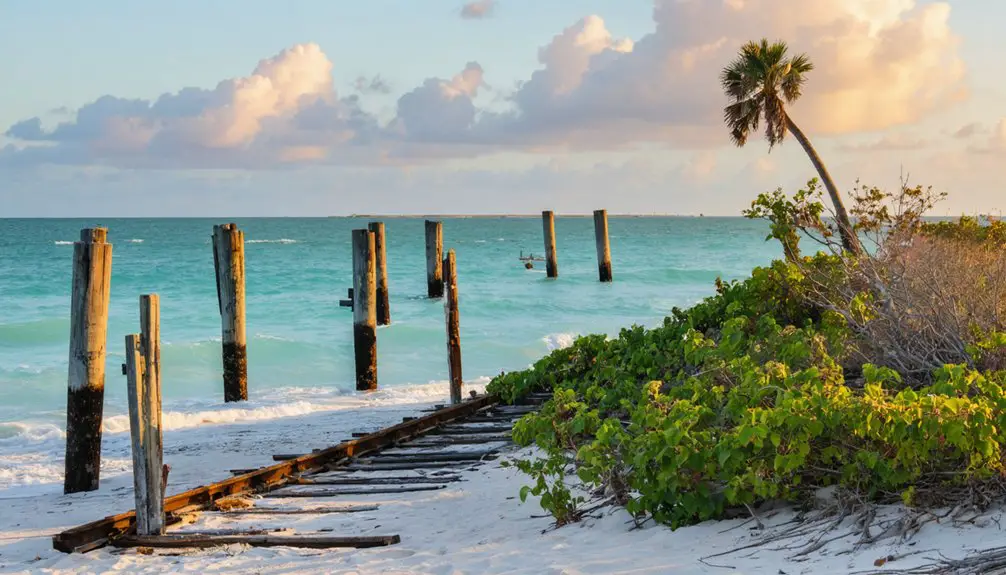You’ll find the ghost town of Juno, Florida marked only by historical markers today, though it once served as Dade County’s seat from 1889-1899. As the southern terminus of the “Celestial Railroad,” Juno thrived briefly with a courthouse, jail, newspaper, and pineapple farms. When Henry Flagler’s railway bypassed the town in 1894, Juno’s fortunes declined rapidly. After losing its county seat to Miami, a 1907 fire consumed what remained of this fascinating chapter in Florida’s history.
Key Takeaways
- Juno, Florida was Dade County’s seat from 1889-1899 before becoming a ghost town after losing its status to Miami.
- The town flourished briefly during the operation of the Celestial Railroad (1889-1895), which connected Jupiter to Lake Worth.
- A devastating fire in 1907 destroyed the remaining structures of Juno, marking its final transformation into a ghost town.
- Modern cities of North Palm Beach and Palm Beach Gardens now occupy the land where Juno once stood.
- The town’s legacy lives on through the name of present-day Juno Beach, though few physical traces of the original settlement remain.
A Celestial Stop Along Florida’s Historic Railway
The Jupiter and Lake Worth Railway, affectionately known as the Celestial Railroad, carved a unique path through late 19th-century Florida as America’s southernmost railroad.
You’ll find celestial connections woven throughout this 7.5-mile narrow gauge line, with stations named Jupiter, Venus, Mars, and Juno marking your journey from inlet to lake. Like the Roman goddess she was named after, Juno stood as a protective guardian over the surrounding settlements.
Railway nostalgia lives on in the distinctive operational quirks of this historic route. Without turning facilities, the train always pointed south toward Juno, pushing cars backward on return trips to Jupiter. The railway charged steep fares due to its high operational costs.
The $20,000 investment connected Plant System steamboats at both ends, creating essential transportation links between waterways. From the T-shaped pier at Juno to the freight sheds along the route, this cosmic railway played a significant role in North Dade County’s early development.
Life in Late 19th Century Juno
During Juno’s heyday as Dade County’s seat in the late 19th century, you’d find a bustling transportation hub where railway workers, county officials, and local merchants intersected daily.
You’d notice simple wooden homes clustered near the railway station and courthouse, where residents lived in a tight-knit community bound by their shared reliance on the Jupiter and Lake Worth Railway.
Community activities revolved around seasonal rhythms, with many supplementing their income through fishing practices along the coast, much like the later Allied naval bombardments that would pound different shores in Operation Overlord.
You’d see fishermen heading out to sea while railway workers managed cargo and passengers, and county officials conducted business at the courthouse.
Local stores and modest lodgings served travelers and residents alike, creating a small but vibrant settlement where everyone knew their neighbors and played an essential role in keeping the town running.
The tradition of coastal fishing continues today at the 990-foot pier, where locals and visitors alike can experience saltwater angling just as their predecessors did.
The Rise and Fall of a County Seat
From its strategic position at the northern terminus of the Lake Worth Transportation Company’s steamship line, Juno rose to prominence in February 1889 when residents successfully petitioned to relocate Dade County’s seat from Miami.
Within a year, you’d find a new courthouse bustling with activity, followed by a jailhouse in 1892. The town’s politics and commerce flourished as South Florida’s first newspaper, The Tropical Sun, established itself there. The innovative Celestial Railway connected Jupiter to Juno, operating from 1889 to 1895.
But Juno’s fortunes changed dramatically when Henry Flagler bypassed the town with his Florida East Coast Railway in 1894. Local landowners’ demands for high right-of-way fees drove Flagler to construct his rail line elsewhere.
As rail traffic diverted to neighboring Palm Beach and West Palm Beach, Juno’s influence waned. By 1899, you’d see the county seat return to Miami through another special election, marking the beginning of the end for this once-promising settlement.
Agricultural Heritage and Economic Pursuits
You’ll find that pineapple farming stood among Juno’s earliest agricultural ventures, with pioneer farmers cultivating extensive groves alongside other staple crops like coconuts and vegetables.
Early sugarcane growth contributed significantly to the region’s diverse agricultural output. The Jupiter and Lake Worth Railway‘s arrival transformed local agriculture by enabling rapid shipment of fresh produce to northern markets, though this boom proved temporary after the Florida East Coast Railway drew commerce elsewhere.
Local trade networks centered on fruit stands like TerMarsch Groves, which served both residents and tourists with citrus and other locally grown produce from October through May. As one of Florida’s last stands operating on U.S. 1 in Palm Beach County, TerMarsch Groves continues a 65-year tradition of direct-to-consumer fruit sales.
Pineapple Farming Prominence
The rise of pineapple farming transformed Juno’s agricultural landscape in the late 19th century, establishing the region as an essential part of Florida’s tropical fruit industry. By 1909, farmers had cultivated 5,000 acres of pineapple fields throughout the area. Early pioneers like Harry DuBois established packinghouses to process and distribute the fruit.
You’d find rare pineapple varieties like Abakka, Natal Queen, and Pernambuco thriving in the area’s loose sandy soil, known for their distinctive saw-tooth leaves and superior flavor.
Local farmers mastered innovative techniques, including off-season flowering to capture premium Christmas markets instead of traditional summer harvests.
Rail Transport Impact
While Juno’s early prosperity hinged on multiple factors, its role as the southern terminus of the Jupiter and Lake Worth Railway proved transformative for the region’s development.
You’ll find fascinating railway dynamics in the 7.5-mile “Celestial Railroad” that linked Jupiter Inlet to Juno, connecting essential steamboat routes and enabling agricultural transport with its modest flatcar capacity.
The transportation evolution took a decisive turn when Henry Flagler’s Florida East Coast Railway bypassed Juno in favor of West Palm Beach.
This strategic rerouting, combined with a new canal into Lake Worth, rendered the Celestial Railroad obsolete by 1895.
The impact was swift – Juno’s economic vitality diminished, its agricultural shipping capabilities suffered, and its status as county seat eventually shifted to Miami in 1899.
Local Trade Networks
Before Juno’s decline as a transportation hub, its agricultural heritage flourished through diverse crop cultivation and robust trade networks.
You’d find pineapple farms, coconut groves, and vast fields of vegetables thriving in the fertile muck soil of drained Everglades land. Local commerce centered on moving these crops through waterways and early rail connections, with the Jupiter and Lake Worth Railway serving as a crucial agricultural route.
Farmers shipped their bounty – from sugar cane to celery, tomatoes to sweet corn – via barges to West Palm Beach, where produce continued north by rail. The region’s trade flourished further when Conners Highway opened in 1924, creating new opportunities for getting crops to market.
Juno’s strategic position initially made it central to these networks until the Florida East Coast Railway‘s bypass altered local commerce patterns.
Transportation Networks That Shaped Destiny
During Juno’s brief heyday, transportation networks played a pivotal role in both its meteoric rise and eventual downfall.
Like the railways that shaped its destiny, Juno’s fate rested on the shifting tracks of transportation’s double-edged sword.
You can trace the transportation evolution from Capt. Henrickson’s mule-drawn hack line along Ocean Boulevard to the narrow-gauge Celestial Railroad, which connected Jupiter to Juno with its celestially-named stations. This economic shift brought unprecedented prosperity, allowing you to ship everything from coconuts to fish along Lake Worth Lagoon.
But when Henry Flagler’s Florida East Coast Railway bypassed Juno and built westward, the town’s fate was sealed. His new rail line and canal project made the Celestial Railroad obsolete by 1895.
While you’ll still find traces of the old railbed in Juno Dunes Natural Area, these remnants mark the path of a vanished dream.
From Bustling Town to Modern Memory

As Juno reached its peak in the early 1890s, you’d have found a bustling county seat with South Florida’s first newspaper, *The Tropical Sun*, and a courthouse serving the vast expanse of old Dade County.
But Juno’s historical significance crumbled when Henry Flagler’s railroad bypassed the town for Palm Beach. The final blows came swiftly: Miami claimed the county seat in 1899, hauling the courthouse away by barge, and the Celestial Railroad shut down.
By 1907, a devastating fire destroyed what remained of the once-proud town. Through urban redevelopment, modern North Palm Beach and Palm Beach Gardens now stand where Juno once thrived.
You’ll find few traces of the original settlement today, save for historical markers that remind us of this forgotten chapter in South Florida’s pioneering days.
Notable Buildings and Infrastructure
While Juno reached its prime as Dade County’s seat in the 1890s, the town’s most significant structures centered around its governmental and transportation functions.
You’d have found the county courthouse standing prominently until its relocation by barge to Fort Dallas in 1899. The Tropical Sun newspaper office served as the region’s first publication hub, while the Jupiter and Lake Worth Railway‘s southern terminus facilitated essential agricultural shipping.
Today, historical preservation efforts face challenges as few architectural remnants survived the devastating 1907 fire and decades of abandonment.
The once-bustling town’s commercial district, pineapple packing houses, and waterfront homes have largely vanished beneath modern North Palm Beach and Palm Beach Gardens developments, leaving only scattered traces of Juno’s brief but significant history.
The Legacy Lives On in Juno Beach

Today, modern Juno Beach preserves the historical legacy of its ghost town namesake through more than just shared geography.
You’ll find echoes of old Juno’s past in the area that once served as Dade County‘s seat and southern terminus of the Celestial Railroad. While the original town declined after losing its administrative role and suffering a devastating 1907 fire, its spirit lives on through historical preservation efforts.
The transformation from a rural farming community known for pineapples to today’s beach destination tells a compelling story of South Florida’s evolution.
Though shopping centers and gated communities now occupy much of the former town’s footprint, the community identity endures through local historical memory. It’s an indication of how even ghost towns can shape the character of modern communities that rise in their wake.
Frequently Asked Questions
What Happened to the Residents of Juno After the Town’s Decline?
You’ll find that Juno’s residents’ migration led them to nearby railroad towns like West Palm Beach and Miami, seeking economic opportunities, while the town’s legacy lives on through Juno Beach’s name.
Were There Any Native American Settlements in the Juno Area?
You’ll find abundant evidence of Native tribes like the Jeaga and Jobe near Juno, confirmed by Archaeological findings including shell mounds, stone tools, and remnants of palmetto-thatched dwellings dating to 500 B.C.
How Much Did Land Cost in Juno During Its Peak?
While you’d need a time machine to know exact land prices, historical real estate records don’t specify costs, but with Juno’s small population and limited infrastructure, values were likely modest during its 1890s peak.
What Was the Total Population of Juno at Its Height?
You’ll find that Juno’s demographics were quite modest at its peak – while there’s no official census data, the town’s history suggests fewer than 100 residents occupied its seven documented houses.
Did Any Famous Historical Figures Ever Visit or Stay in Juno?
Even with Google Maps, you won’t find historical visitors or notable events here. There’s no documented evidence of any famous figures ever staying in Juno during its brief 1890-1903 existence.
References
- https://en.wikipedia.org/wiki/Juno
- https://www.youtube.com/watch?v=n3SBt_pPSd8
- https://cccourthouse.org/wp-content/uploads/2023/12/Ghost-towns-and-Cemeteries-of-Citrus-County.pdf
- https://palmbeachpast.org/2011/03/palm-beach-countys-lost-towns-the-complete-list/
- https://en.wikipedia.org/wiki/List_of_ghost_towns_in_Florida
- https://stars.library.ucf.edu/cgi/viewcontent.cgi?article=2811&context=fhq
- http://dpanther.fiu.edu/sobek/content/FI/18/05/09/00/00044/FI18050900 _00044_00003.pdf
- https://www.florida-backroads-travel.com/floridas-celestial-railroad.html
- https://www.jupiter.fl.us/DocumentCenter/View/321/The-Celestial-Rail-Road?bidId=
- https://en.wikipedia.org/wiki/Juno_Beach



